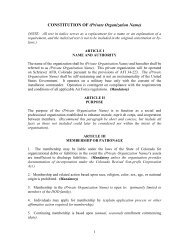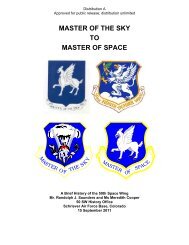310TH SPACE WING (AFRC) (310 SW) - Schriever Air Force Base
310TH SPACE WING (AFRC) (310 SW) - Schriever Air Force Base
310TH SPACE WING (AFRC) (310 SW) - Schriever Air Force Base
You also want an ePaper? Increase the reach of your titles
YUMPU automatically turns print PDFs into web optimized ePapers that Google loves.
4<br />
Master of Space<br />
General Bernard A. <strong>Schriever</strong><br />
A technological visionary...<br />
A pioneer in the research and development of new ballistic missile and space programs...<br />
A dynamic, innovative leader and valued advisor...<br />
Th e architect of the <strong>Air</strong> <strong>Force</strong>’s ballistic missile and<br />
military space program, Bernard Adolph <strong>Schriever</strong> was born<br />
in Bremen, Germany, in 1910 and migrated to the United<br />
States with his parents in 1917. His family settled in the<br />
German-American community of New Braunfels, Texas. He<br />
became a naturalized citizen in 1923, attended grade and<br />
high school in San Antonio and graduated from Texas A&M<br />
University in 1931 with a Bachelor of Science. He was<br />
commissioned in fi eld artillery, but in July 1932 began fl ight<br />
training at Randolph Field and earned his pilot wings and<br />
commission in the <strong>Air</strong> Corps in June 1933 at Kelly Field. He<br />
was then assigned as a bomber pilot at March and Hamilton<br />
Fields, Calif.<br />
In 1934, <strong>Schriever</strong> fl ew Army <strong>Air</strong> Corps airmail missions<br />
during the bitter cold of winter. Many of his comrades<br />
crashed to their deaths piloting the antiquated and poorly<br />
equipped planes provided. Th is experience underscored<br />
for him the consequences of technological inferiority and<br />
demonstrated the need to modernize and build up air power<br />
if the United States hoped to compete with other air forces<br />
internationally.<br />
During the Great Depression, <strong>Schriever</strong> learned leadership<br />
while commanding a Civilian Conservation Corps unit in<br />
New Mexico providing shelter, sustenance and guidance to<br />
unemployed young men.<br />
In September 1937, he went to Panama for duty at Albrook<br />
Field and then briefl y left the <strong>Air</strong> Corps to fl y as a pilot with<br />
Northwest <strong>Air</strong>lines. He returned to duty in October 1938<br />
with the 7th Bomb Group at Hamilton, Calif., and a year<br />
later became a test pilot at Wright Field, Ohio, where he also<br />
attended the <strong>Air</strong> Corps Engineering School, graduating in<br />
July 1941. He then earned a master’s degree in aeronautical<br />
engineering from Stanford University.<br />
Just as the United States entered World War II, he earned<br />
his commission in the Army. In July 1942, <strong>Schriever</strong> served<br />
in the Southwest Pacifi c with the 19th Bomb Group (5th <strong>Air</strong><br />
<strong>Force</strong>) for combat.<br />
As a B-17, B-25 and C-47 pilot, he fl ew 38 combat<br />
missions, participating in the Bismarck Archipelago, Leyte,<br />
Luzon, Papua, North Solomon, South Philippine and<br />
Ryukyu campaigns.<br />
His superiors quickly recognized <strong>Schriever</strong>’s technical skills<br />
and steadily promoted him in rank from captain to colonel,<br />
and in position from Chief of Maintenance and Engineering<br />
to Chief of Staff , 5th <strong>Air</strong> <strong>Force</strong> Service Command in January<br />
1943. By September 1944, he commanded the Advanced<br />
Headquarters, Far East <strong>Air</strong> Service Command, which<br />
supported theater operations from bases in Holland, New<br />
Guinea, Philippines and Japan.<br />
In January 1946, <strong>Schriever</strong> was assigned to the Pentagon<br />
to head the Scientifi c Liaison Offi ce, under the Deputy Chief<br />
of Staff for Materiel. Although young in years, <strong>Schriever</strong><br />
had drawn the attention of senior offi cers, especially the<br />
commander, General Henry H. “Hap” Arnold. Recognizing<br />
his protégé’s rare combination of leadership attributes,<br />
engineering training and combat experience, General Arnold<br />
entrusted <strong>Schriever</strong> with the delicate job of maintaining close<br />
ties forged during the war between the <strong>Air</strong> <strong>Force</strong> and leading<br />
scientists.<br />
<strong>Schriever</strong>’s offi ce introduced development planning<br />
objectives, an invaluable series of planning documents that<br />
matched long-range military requirements with ongoing<br />
©2012 Benchmark Publications, Inc.














